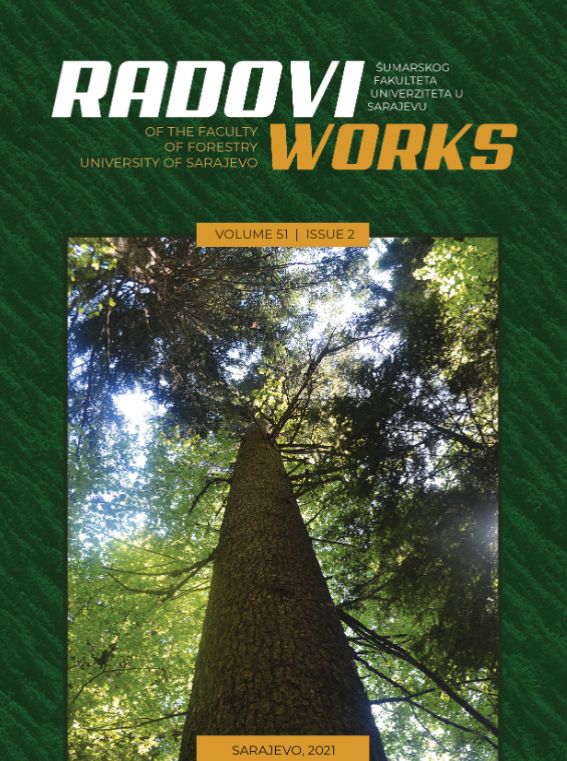Age of trees of fir (Abies alba Mill.), spruce (Picea abies Karst.) and beech (Fagus sylvatica L.) in mixed uneven-aged multilayered stands on mountain Igman
DOI:
https://doi.org/10.54652/rsf.2021.v51.i2.355Abstract
This particular paper analyzes the age of fir (Abies alba Mill.), spruce (Picea abies Karst.) and beech (Fagus sylvatica L.) trees, with a diameter at breast height of approximately 50 cm (diametar classes 47.5 and 52.5 cm) in mixed uneven-aged multi-leyerd stands. Research data was obtained from four continuous experimental plots on Mt. Igman, with different site conditions and stand structure on which the selective management method is carried out. Based on the number of annual growth rings on the incerement cores to the center of the tree taken at a height of 1.3 m, the so-called "age of growth" was determined (Flury according to Stamenković, Vučković 1988). However, the actual age is greater than the determined age, for the time required to reach a height of 1.3 m. The research indicated that the tree age is of great variability. The range for fir trees is from 70 to 350 years, for spruce trees from 65 to 256 years and for beech trees from 113 to 275 years. Moreover, the research implicates that the differences in age between tree species within one stand aren't statistically significant in all analyzed cases, while differences between trees of the same tree species from stands of different site and stand conditions are statistically significant. The differences between the observed fir and beech trees in the same stand are not statistically significant, while the differences between the trees of these tree species and spruce trees are statistically significant. For all observed tree species, it was found that the age of trees is on average lower in sites of medium quality, compared to sites of better and lower quality. It was concluded that differences in the age of observed trees are determined by tree species, site conditions and stand structure (competitive relations) and other factors not covered by this study, and that the age of trees of certain species to some extent indicates the production potential of sites.
References
Abrams, M. D. (1985). Age-Diameter relationship of Quercus species in relation to edaphic factors in gallery forests in northeast Kansas. Elesevier Science Publishers B. V. 85; p. 181-193. https://doi.org/10.1016/0378-1127(85)90033-7
Blum, M. B.. (1961). Age-size relationship in all-aged northern hardwoods. Forest Research Note NE-125. Upper Darby, PA: U.S. Department of Agriculture, Forest Service, Northeastern Forest Experiment Station. 1-3. https://www.fs.usda.gov/treesearch/pubs/13077
Del Rio, M., Pretzsch, H., Alberdi, I., Bielak, K., Bravo, F., Brunner, A., Conde´s, S., Ducey, J. M., Fonseca, T., Von Lupke, N., Pach, M., Perić, S., Perot, T., Souidi, Z., Spathelf, P., Sterba, H., Tijardović, M., Tomé, M., Vallet, P., Bravo, O. A. (2016). Characterization of the structure. dynamics. and productivity of mixed-species stands: reviewand perspectives. Springer. European Journal Forest Research 135(1):23-49. DOI: 10.1007/s10342-015-0927-6.
Drinić, P. (1974). Dinamika rastenja i prirašćivanja bukve, jele i smrče u najvažnijim tipovima bukovo-jelovih šuma na Igmanu. Radovi Šumarskog fakulteta i Instituta za šumarstvo u Sarajevu, knj. 17, sv. 4-6.
Drinić, P. (1976). Dinamika rastenja jele i smrče u najvažnijim tipovima četinarkih šuma na Igmanu. Radovi Šumarskog fakulteta i Instituta za šumarstvo u Sarajevu, knj. 19, sv. 1.
Frančišković, S. (1938). Prilog proučavanja taksacionih elemenata u prebirnim šumama. Šumarski list, br. 10, p. 469-475. https://www.sumari.hr/sumlist/193808.pdf#page=42
Gibbs, B. C. (1963). Tree diameter a poor indicator of age in west Virginia hardwoods. Research Note NE-11. Upper Darby, PA: USDA. Forest Service Research. Northeastern Forest Experiment Station. 1-4. https://www.fs.usda.gov/treesearch/pubs/11607
Ibrahimspahić, A. (2013). Prirast i razvoj sastojina bukve, jele i smrče u GJ „Igman“. Doktorska disretacija. Šumarski fakultet Univerziteta u Sarajevu.
Kenefic, S. L., Nyland, D. R. (1999). Sugar Maple Height-Diameter and Age-Diameter Relationships in an Uneven-Aged Northern Hardwood Stand. USDA. Forest Service Research. Northern Journal of Applied Forestry 16 (1): 43-47. https://www.fs.usda.gov/treesearch/pubs/35683
Klepac, D. (1953). Vrijeme prelaza. Šumarski list 1, p. 37-50. https://www.sumari.hr/sumlist/195301.pdf#page=39
Leak, W.B. (1985). Relationship of tree age to diameter in old-growth northern hardwoodand spruce-fir. Res. Note NE-329. Broomall, PA: USDA. Forest Service Research. Northeastern Forest Experiment Station. 4 p. https://www.fs.usda.gov/treesearch/pubs/21605
Loewenstein, E. F., Johnson, P.S., Harold, E.G. (2000). Age and diameter structure of a managed uneven-aged oak forest. Canadian Journal of Forest Research 30; 1060–1070. DOI:10.1139/CJFR-30-7-1060
Matić,V. (1959). Taksacioni elementi prebornih šuma jele, smrče i bukve na području Bosne, Radovi Šumarskog fakulteta i Instituta za šumarstvo i drvnu industriju u Sarajevu, br 4. Sarajevo.
Matić, V. (1980). Prirast i prinos šuma. Šumarski fakultet Univerziteta u Sarajevu.
Pavlič, J. (1987). Završni izvještaj po istraživačkom projektu Prirast i prinos mješovitih šuma bukve, jele i smrče (u najvažnijim tipovima ovih šuma na području privredne jedinice “Igman”). Šumarski fakultet Univerziteta u Sarajevu.
Schütz, J.P. (2001). Der Plenterwald und weitere Formen strukturierter und gemischter Wälder. Parey Buchverlag Berlin.
Stamenković, V., Vučković, M. (1988). Prirast i proizvodnost stabala i šumskih sastojina. Šumarski fakultet Univerziteta u Beogradu.
Downloads
Published
How to Cite
Issue
Section
License
Copyright (c) 2021 Aida Ibrahimspahić, Adis Selman, Azra Čabaravdić, Azer Jamaković

This work is licensed under a Creative Commons Attribution 4.0 International License.


















